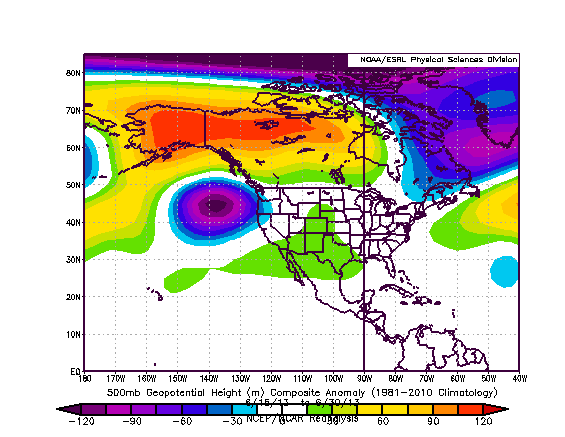The very wet weather pattern continues across The Northeast and Mid-Atlantic States and it is not done with us just yet.
The anomalous pattern of moist tropical air flowing from the Gulf of Mexico and the Southwest North Atlantic Ocean up the East Coast to the Northeast is one reason why it has been so wet this month (and even last month, too). Below is the GEFS (
Global
Ensemble Forecast
System) forecast map for the forecast winds at 850 hPa and the +2 to +4
Standard
Deviation (SD) of the wind at this level; the map is for late afternoon of the 27th.
The water vapor in the air was way above normal for this time of year, with SD values of +2 to +3 SD as shown in the map below.

When this moisture interacted with a strong low pressure system (for the time of year) then the rain was both widespread and very heavy especially when embedded convection occurred within the storm's rainshield.

The map to the riggt is the GEFS forecast map for the early morning of June 28th. The low pressure system was over Pennsylvania with a pressure anomaly of -3
Standard
Deviations (SD)
BELOW normal for late June.
The June 27th 8PM EDT sounding for Albany, NY is below. [ A sounding is a radiosonde that records temperature, moisture and wind speed and direction above the ground. Soundings are very useful in daily weather forecasting; the information from them can be used to: forecast maximum temperature or precipitation type or amount; assess instability in the atmosphere (which is helpful in thunderstorm forecasting) to name but a few ways that this information can be used]. The analysis of this data [temperature trace is in red, dew point (moisture) data in dashed green and the wet bulb solid lighter green ] indicated that the airmass above Albany was convectively unstable and very moist from the ground up through a great height. The sounding also indicated that the warm air extended above twenty thousand feet. This is significant; case studies of past flash flood events for the Eastern U.S., especially for areas east of the Appalachians, showed that heavy rain producing convection occurs with very warm air aloft. Cloud top temperatures of these convective cells are warmer than -62°C. This "warm topped" convection that formed combined with both larger scale and mesoscale features all interacted in time and place to cause maximum precipitation efficiency and the resulting heavy rainfall. [
1]
While thunderstorms were forecast they would not be severe; however thunderstorms and embedded convective showers within the storm's rain area would likely produce downpours due to the warm and moist nature of the air. Various indices also indicated the instability of the air and supported heavier showers.
The Convective Hazards Assessment Program (CHAP) (aka Ricks Index or RI) is another analysis tool that uses from data soundings to assess both severe storm potential and for forecasting potential rainfall amounts. The CHAP
[2] analysis (not shown) indicated NO severe thunderstorm; the rainfall calculator (a part of the CHAP), indicated 4.76" of rain with a maximum potential rainfall of 5.58" was possible.
The heaviest rains fell across the Western Mohawk Valley and Southern Herkimer County of NY State. Note the rain totals at Ilion, Little Falls, and Columbia Center and compare it to the CHAP forecast precipitation.
The surface pressure anomaly, 850 hPA wind data and anomalies and the 500 hPa heights and anomalies (data not shown) indicated the threat for a flooding rain storm was quite likely. The use of ensemble and anomaly data is a very useful tool in forecasting "abnormal" or "extreme" weather events. If all the weather elements of moisture, wind and lift are forecast to come together in time and place and the anomaly data indicates these features have a significant deviation from normal then the forecaster has a higher confidence in the outcome of the forecast and can even assign a probability of the event occurring..
This flash flood event "fit" a Gulf (of Mexico)/Tropical (moisture) Origins event type. [
3]
Other Factors that caused the Flash Flood [4]
- Wet antecedent conditions across the Upper Mohawk River and the Western Mohawk Valley
- The slope of the Western Mohawk Valley is very STEEP from the Adirondack Mountains to the north and the Mohawk Valley
- Clay soil
- Land use - Southern Herkimer County and Western Montgomery & Fulton Counties are farmland with some light industrial development
References:
[
1]
Flash Flood Forecasting: An Ingredients-Based Methodology, Doswell, et al.
Weather and Forecasting, December 1996/Vol. 11
[2] Convective Hazards Assessment Process: Revised Ricks Index,
Ricks & Erickson AMS Storm Conference Preprints 2008
[
3]
The Use of Ensemble and Anomaly Data to Anticipate Extreme Flood Events in the Northeastern United States, Stuart and Grumm
National Weather Digest
[4] From NWS Albany NY
Seminar for Broadcast Meteorologists May 2013

















































